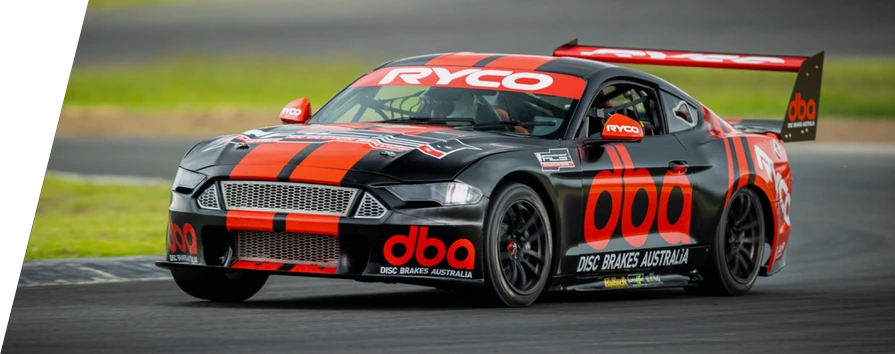ABS
Anti-lock Braking System; Typically, the ABS system consists of an electronic control unit (ECU), four-wheel speed sensors and a hydraulic valve fitted in the circuit between the master cylinder and brake calipers. The ECU monitors wheel speed to predict loss of tractive contact between the tyre and the road. The ABS system overrides the brake system hydraulics to initiate cadence braking (onoff) to avoid wheel lock up and loss of control.
ABRASIVE FRICTION
In braking Abrasive Friction is the generation of brake torque through material interference causing a grinding effect on both brake pad and disc rotor. Abrasive friction is essential for maintaining friction consistency in heavy duty or high-performance applications. Semi-Metallic brake pads use abrasive friction.
ABUTMENT CLIPS
Abutment clips are the complimentary hardware components that are fitted to the brake caliper to accommodate the brake pads. These components are used to reduce wear on the caliper mating faces and to apply spring force on the pads to reduce vibration or assist in retraction from the rotor face when the brake pedal is released.
BACKING PLATE
Is the steel component in a brake pad that provides adequate stiffness to evenly distribute the force output by the caliper piston/s across the surface area of the brake pad friction material. The backing plate profile is also shaped to fit the caliper guides to ensure proper positioning of the pad material and accommodate anti-vibration springs to minimise noise.
BEDDING IN
Bedding in is the process of conditioning the friction surfaces of the disc rotor and pads to prepare the brakes for normal driving. The process includes heat cycling of all components and often the formulation of what is known as a third layer on the disc braking surface to aid in the friction process. The third layer is a blend of pad and disc material bonded onto the disc which is replenished throughout the life of the product. Poor application of this process often leads to vibration and performance issues with both products.
The process can vary greatly depending on the disc rotor and brake pad technology used and is best left to experienced vehicle technicians who will follow the manufacturer’s instructions.
BITE
Bite is level of friction response when the brakes are first applied. Brake bite is often referenced as high or low initial bite. High being a very fast reaction in brake torque and low being a gradual build-up of brake torque when applying the brake pedal.
BLEEDING
Bleeding the brakes is the process of purging the hydraulic brake fluid and trapped air anywhere from the circuit between the fluid reservoir and the bleed nipple fitting on the brake caliper. Typically, the fluid and air is evacuated via the caliper bleed nipples on each corner of the vehicle. Bleeding is required to remove any trapped moisture or air that causes a soft brake pedal due to its compressibility while replacing the old fluid with new.
BRAKE BIAS
Brake Bias refers to the ratio of brake torque generated from front to rear. Typically, the brake bias is a similar ratio to the weight distribution of the vehicle, front to rear. Common ratios in standard vehicles are approx. 70:30 front to rear with high performance and race vehicles striving for 60:40 or even 50:50 weight distribution and brake bias to maximise vehicle dynamics. Adjustable brake bias systems are sometimes fitted to race vehicles to adjust the brake torque whilst in motion to compensate for weight reduction due to fuel burn.
BRAKE BOOSTER
The brake booster is a vacuum operated servo device fitted between the brake pedal mechanism and the brake master cylinder. The brake booster is designed to multiply the force generated on the brake pedal and reduce the driver effort required stop the vehicle safely. The vacuum pressure is typically generated naturally from the intake manifold or mechanically via a vacuum pump. Most hydraulically braked passenger vehicles have a brake booster.
BRAKING EFFICIENCY
Braking efficiency is the actual deceleration rate in “g” units (g-force), divided by the maximum deceleration rate achievable prior to loss of road traction or wheel lockup expressed as a percentage (%). 100% braking efficiency produces the minimum stopping distance for a given vehicle which is governed by tire adhesion to the road.
BRAKE FLUID
The fluid used in a brake system required to transfer the pressure generated by the master cylinder assembly to the brake caliper pistons which force the brake pads onto the disc rotor. Hydraulic fluid is used due to its lack of compressibility and hygroscopic properties, therefore more responsive. Typical brake fluids are glycol-ether based with some mineral and silicone based alternatives. Common grades of brake fluid are DOT 3, DOT 4, DOT 5.1 with increasing wet (>3.7% moisture) and dry boiling points respectively. Please Note; DOT 5 Silicone based fluids are not to be used in brake systems that are not specifically design for this fluid. It is not compatible with most ABS systems and can cause internal corrosion.
BRAKE TORQUE
Brake Torque is the is the amount of resistance force created by the hydraulic clamping action of the caliper or wheel cylinder and friction material on the disc rotor or drum. This resistance force is then transferred through the tyres to the road surface. The metric unit of measure is Newton Meters.
CALIPER
The caliper is the static hydraulic clamping device connected to the stub axle, that applies pressure to brake pads creating brake torque or resistance to rotary motion of the brake disc and tyre.
CAST IRON
Cast iron is the type of metal commonly used in disc rotor and caliper production. The component is produced by casting molten iron into a mould made of sand.
COEFFICIENT OF FRICTION
Coefficient of friction refers to the relationship between the force of resistance between two objects. The unit of measure used to define COF is mu. (Greek letter “μ”)
COHESIVE FRICTION
In braking cohesive friction is the generation of brake torque through adhesion between the brake pad to the disc rotor. A layer of pad material is formed on the disc commonly known as a transfer layer. This layer is typically a light brown or grey colour.
The substrate of each component, the brake pad and the transfer layer on the rotor attempt to bond together causing a gripping sensation. Cohesive friction typically results in less rotor and pad wear in light duty applications. NAO brake pads use cohesive friction.
DRILLED OR CROSS DRILLED ROTORS
A disc rotor with a pattern or series of holes drilled perpendicular to the friction surface to aid in the evacuation of friction dust and gasses.
DRUM IN HAT
Drum in hat refers to a rear disc rotor with a hand brake drum integrated into the mounting bell.
DTV
Disc Thickness Variation is when the two friction ring surfaces of a disc rotor are not parallel in a rotary motion. This causes oscillation of the brake pads and hydraulics resulting in brake pedal pulsation or brake shudder.
BRAKE FADE
Brake fade is the temporary reduction of friction performance when the disc rotor and pad can no longer generate sufficient friction resistance due to exceeding the specified operating temperatures of the brake pad material. Green fade refers to the initial loss of friction due to excess resin burn off when bedding new brake pads. Typically, a once off occurrence.
GROOVING
The formation of circular grooves on the disc rotor friction surface. This also has an adverse effect with brake noise.
HEAT CHECKING
Heat checking also known as crazing is the formation of small cracks on the rotor friction surfaces as a result of thermal stress or fatigue.
HIGH CARBON
It is generally accepted that in order to be classified as a high carbon iron, the carbon content of the material has to fall within the range 3.6 – 3.9%.
HYGROSCOPIC
The tendency of a material to absorb moisture from the air or environment. Brake fluid and some brake pads are hygroscopic.
LEADING EDGE
Referring to brake pads this is the edge of the pad that is first receiving the friction surface of the disc rotor.
MASTER CYLINDER
The device that converts a linear force from the brake pedal into hydraulic pressure transferred to the brake caliper.
MATERIAL TRANSFER
The process of depositing material from the brake pad onto the rotor surface.
MODULATION
Controlling brake torque by applying the brake pedal firmly and releasing to achieve the desired deceleration rate.
OEM
Original Equipment Manufacturer. The original manufacturer of the vehicle.
PILLAR VANE
A series of columns forming the support structure in the centre void of a ventilated disc rotor, joining the two friction faces.
RUN OUT
Disc rotor run-out is when the rotor is not rotating on the same axis as the axle. This misalignment causes the friction ring to oscillate back and forth between the brake pads. A common cause of DTV.
SEMI-METALLIC
A brake pad with metal as a primary element of the friction compound. Refer to abrasive friction.
SLOTTED DISC
A disc rotor with grooves machined in the friction surface to aid in removal of dust and debris.
SOLID DISC
A disc rotor with a single solid friction ring as opposed to a ventilated type with two friction rings separated by a void. This is common with disc rotors less than 16mm thick.
SQUEAL (GROAN)
This is an undesirable audible sound emitting from the brake assembly due to vibration. Squeal being a high frequency (pitch) noise and groan, a lower frequency.
TWO PIECE DISC
A disc rotor comprising of two main components, the friction ring and the mounting bell, held together by a series of hardware components. The mounting bell is typically a lighter weight material such as Aluminium. The friction is typically cast iron or a carbon composite material.
VENTILATED DISC
A disc brake rotor with a void between the two friction rings to aid in weight reduction and cooling.
WEAR SENSOR
An audible mechanical device or electronic device connected to the driver console that is fitted to the brake pad to alert the driver when the brakes are worn to their minimum value.

